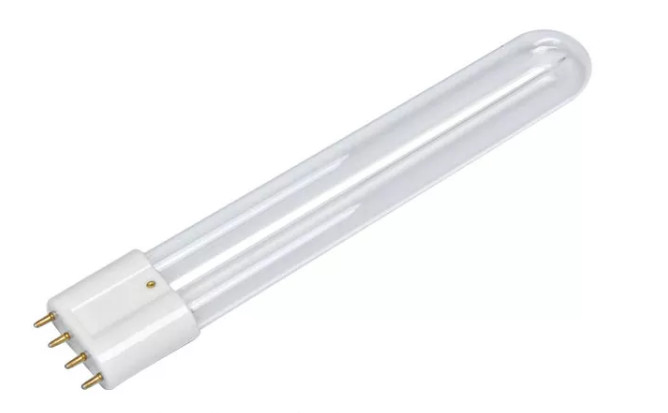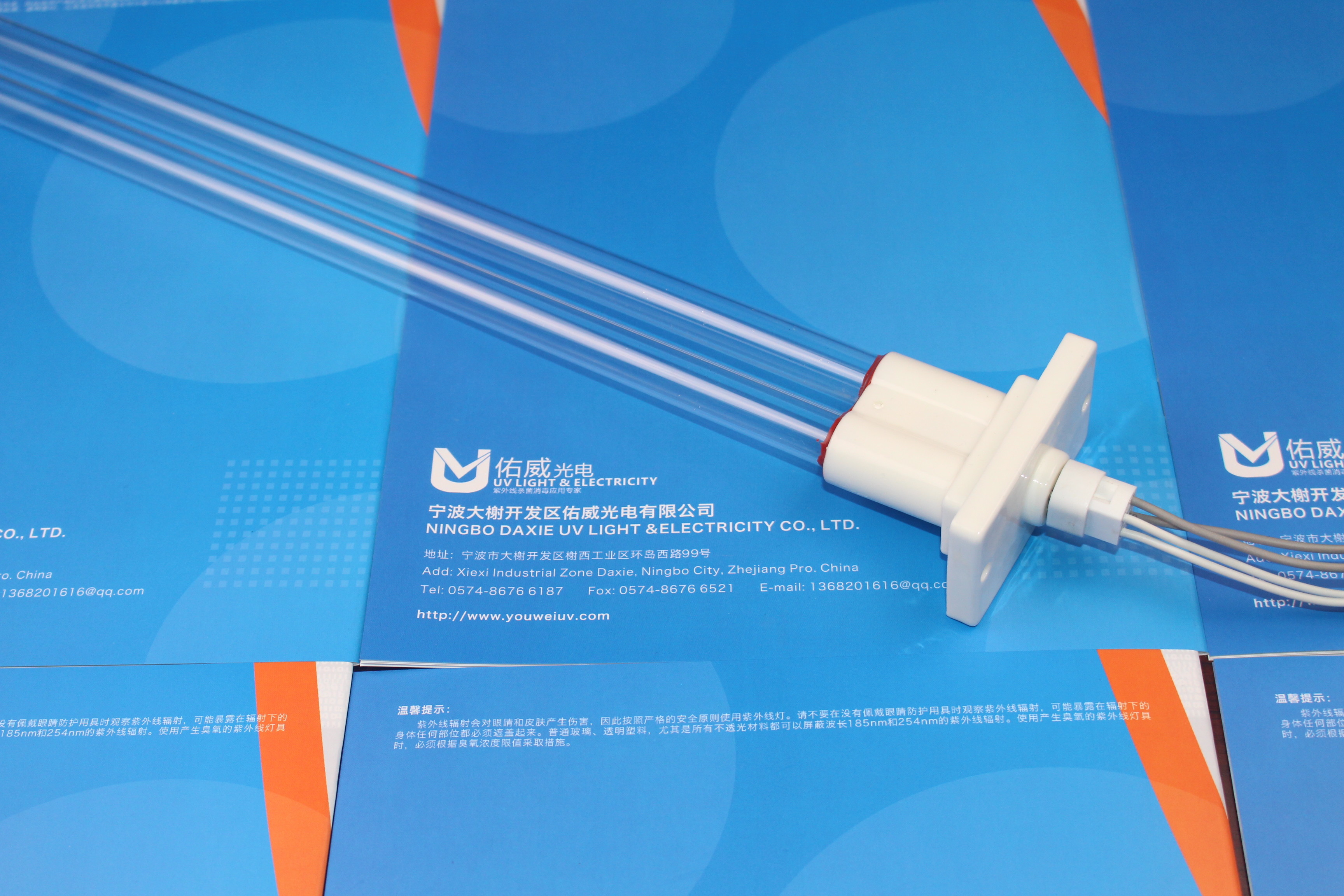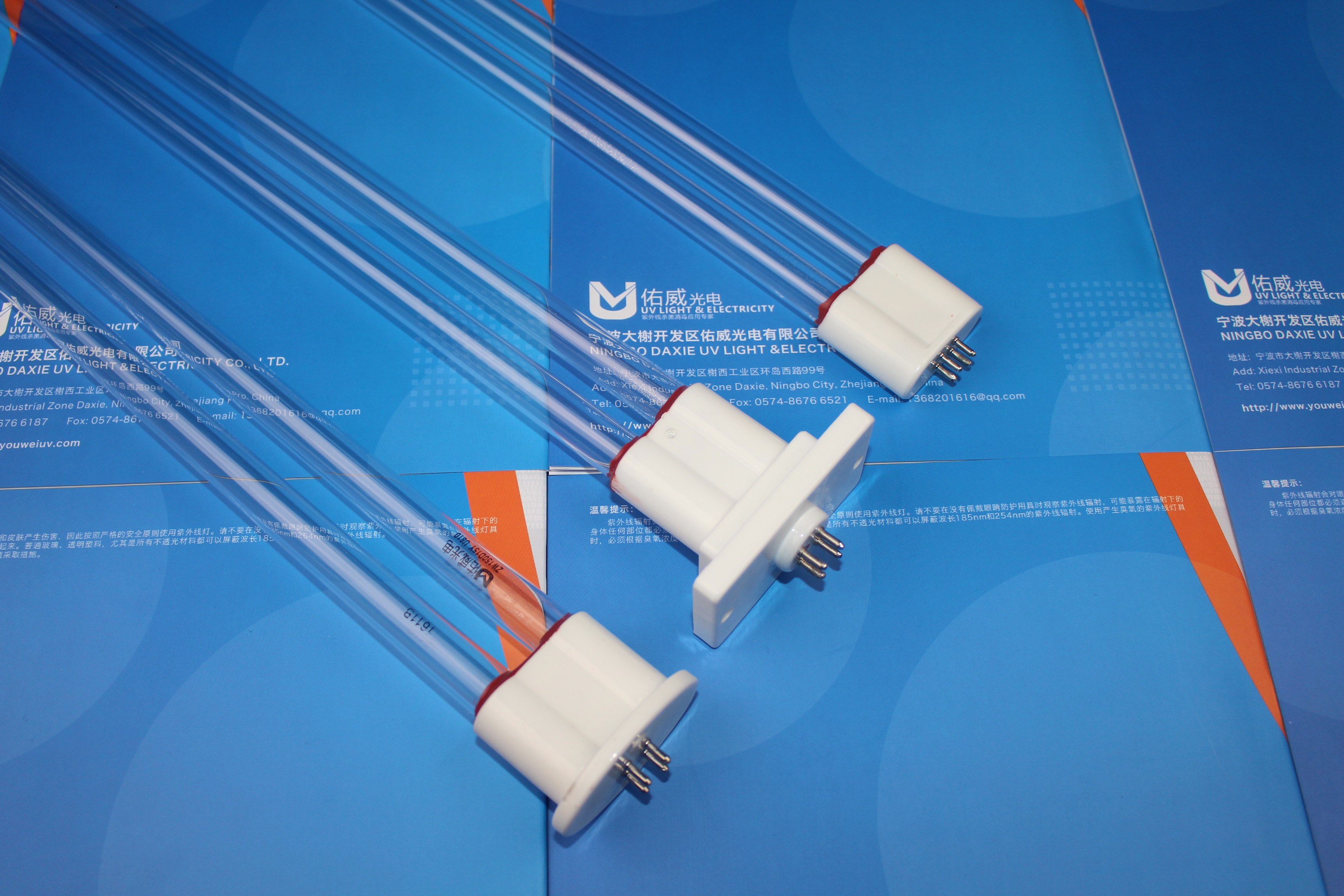WASTE GAS TREATMENT UV LAMP
40w-300W U Type Uvc Tube Industrial Oil Waste Gas Treatment Lamp U Shape Odor Purification Amalgam Ultraviolet Light
|
Light Source
|
Quartz Tube
|
|
wavelength(nm)
|
253.7
|
|
Rated Power
|
40-300W
|
|
Diameter
|
17mm
|
|
Base face length
|
533
|
|
Head material
|
ceramics
|
|
Single head or double head
|
Sigle-ended
|
Ningbo UV Light & Electricity Co.,Ltd is a professional manufacturer of ultraviolet germicidal lamp and related products, integrating R&D, production, sales together. UV germicidal lamp is our main product, incuding sing-ended, double ended, U shape, H shape, amalgam UV lamps, etc.
The Eight Core Technologies
1.Core filament electronic power processing technology. 2.Use the best quality raw materials----Glass tube UV transmittance>93%. 3.Unique inner coating film and outer coating film technology. 4.Solid mercury----Homemade special mercury fixation to improve light efficiency. 5.Unique patented rapid leak detection technology 6.Unique wick anti-vibration patented technology . 7.The most advanced automated processing equiment in China. 8.Cost advantage and perfect pre-sales and after-sales service.
The industrial photo-oxygen catalytic exhaust gas purifier can effectively remove odor, and can effectively remove major pollutants such as volatile organic compounds (VOC), inorganic substances, hydrogen sulfide, ammonia, mercaptans, etc., as well as various odors, and the deodorization efficiency can reach the highest More than 99%.
1. Application principle
Let's talk about UV
Ultraviolet radiation is a general term for radiation with wavelengths from 100nm (nanometer) to 400nm in the electromagnetic spectrum, of which the wavelengths from 100nm to 200nm are vacuum ultraviolet (UV-D), the wavelengths from 200nm to 280nm are short-wave ultraviolet (UV-C), and the wavelengths from 280nm to 315nm It is medium-wave ultraviolet (UV-B), and the wavelength of 315nm to 400nm is long-wave ultraviolet (UV-A). The wavelength of ultraviolet light is inversely proportional to the energy. The longer the wavelength, the better the ability to penetrate the skin or air. The shorter the wavelength and the stronger the energy, the easier it is to cause skin lesions. UV-D cannot be effectively transmitted in the air, and UV-C with shorter wavelength is almost absorbed by the ozone layer. Therefore, the ultraviolet rays in natural sunlight are mainly UV-A and UV-B, of which UV-A accounts for about 98.1%, with UV-B accounting for 1.1%. To say a few more words, UV-A can penetrate the skin epidermis to the dermis, and act on the epidermal melanin of the skin, thereby causing skin melanosis and darkening the skin. However, UV-B can hardly penetrate the skin epidermis. A small amount of exposure to the skin will promote blood circulation and generate vitamin D3, which has a health care effect. Ultraviolet lamps that emit UV-B bands are also commonly known as health lamps. When time acts on the skin, photodermatitis can occur, erythema, itching, blisters, edema, etc. appear on the skin, and excessive ultraviolet radiation can also cause skin cancer. A moderate amount of sun exposure every day can supplement calcium, which is beneficial to the human body. Generally, 15 minutes of sun exposure a day is enough. If it is irradiated by too much ultraviolet rays, it will damage the skin of the human body. In addition to tanning and sunburning the skin, UV rays can also accelerate skin aging. The short-wave ultraviolet lamp uses the characteristics of mercury atoms to excite the mercury vapor during gas discharge to emit ultraviolet rays of 254nm UV-C and 185nm UV-D wavelengths. UV-A and UV-B are the corresponding fluorescence of 254nm UV-C irradiation. The ultraviolet rays emitted by powder, by the way, short-wave UV-C is currently widely used in sterilization and disinfection products, and it emits a large amount of ultraviolet energy. If the bare skin is irradiated by this type of ultraviolet light, it will cause redness, swelling, itching, and scaling in mild cases; in severe cases, it may even cause canceration and skin tumors. At the same time, it is also an "invisible killer" of the eyes, which can cause inflammation of the conjunctiva and cornea, and long-term exposure may lead to cataracts.
Let's talk about the exhaust gas part
VOCs (volatile organic compounds) mainly include benzene, toluene, xylene, styrene, trichloroethylene, chloroform, trichloroethane, diisocyanate (TDI), diisocyanate, etc. and volatile malodorous gases such as Saturated hydrocarbons (such as butadiene, styrene), nitrogen compounds (such as ammonia, methylamine, skatole), sulfides (such as hydrogen sulfide, methyl sulfide), chlorocarbons (such as chloroform), oxygenated hydrocarbons (such as acetone), plant essential oils (such as camphor oil) and other compounds.
Most of the odor pollutants are gas-phase pollutants, mainly composed of carbon, hydrogen, oxygen, nitrogen, sulfur, halogen and other elements. As far as the chemical structure is concerned, the odorant molecules have the characteristic of stimulating the human sense of smell because of the residual electrons.
Waste gas treatment technology is currently divided into three categories: physics, chemistry, and biology. Generally, a single technology or a combination of two or more technologies can be used to complete a single odor treatment. The commonly used physical methods are activated carbon adsorption or acid-base water washing and spraying, the chemical methods are chemical washing and incineration, and the biological methods include biological washing, plant liquid spraying, biological trickling filtration, biological filter beds, etc. , and developed the plasma deodorization method.
The use of 254nm wavelength + 185nm wavelength dual-band high-efficiency ultraviolet lamps to treat exhaust gas has been transferred from abroad to China in the past two years, and is now widely used in China. The essence is to use the O3 ozone produced by the combination of UVD185 nanometer band and O2 to oxidize and reduce the waste gas; the second is to use the high energy of 185 nanometer short-wave ultraviolet to crack the organic waste gas; the third is to use the 254 nanometer ultraviolet light to irradiate the medium coated with TIO2 -OH is produced to oxidize organic waste gas.
Second, the technical characteristics of photolysis and photocatalytic waste gas treatment:
1. Efficient deodorization:
Dual-band ultraviolet light combined with TiO2 photolysis catalytic oxidation equipment can efficiently remove major pollutants such as volatile organic compounds (VOC), inorganic substances, hydrogen sulfide, ammonia, mercaptans, etc., as well as various odors, and the deodorization effect greatly exceeds the national 1993. (GB14554-93) odor pollutant emission standard promulgated in 2008. Nine categories of 114 pollutants published by the US Environmental Protection Agency have been confirmed to be treated by photolysis and photocatalytic oxidation, and even atomic organics such as halogenated hydrocarbons, fuels, nitrogen-containing organics, and organophosphorus pesticides are also well removed. Effect.
2. Wide range of application:
It can adapt to the deodorization and purification treatment of high and low concentration, atmospheric volume, and different odorous gas substances, and can work continuously 24 hours a day, with stable and reliable operation.
3. Low operating cost:
The equipment has no mechanical action, no noise, no need for special personnel management and daily maintenance, only regular inspections, low energy consumption of the equipment, extremely low wind resistance of the equipment <50pa, which can save a lot of energy consumption of exhaust power. Among them, the life of the TiO2 catalyst is infinitely extended and does not need to be replaced.
4. High technology content:
Advanced advanced oxidation technology is adopted to break through the reaction limitation of a single system. In the whole reaction system, two oxidants with strong oxidizing ability—O3 and OH participate in the reaction and 185nm high-energy ultraviolet rays directly crack the exhaust gas, which makes the deodorization effect better. The odorous gas has a higher degree of mineralization and can be discharged harmlessly without secondary pollution.
5. The equipment occupies a small area and is light in weight:
It is suitable for special conditions such as compact layout and small site; made of high-quality imported materials, waterproof, fireproof, anti-corrosion, and long service life.
6. Product performance is stable:
At present, the technology of UV lamps and special high-power ballasts is mature. In order to facilitate maintenance and repair in the future, each ballast is provided with power supply and working indicator lights, and the lamp or rectifier fault can be checked according to the indicator lights. According to the feedback of the bad phenomenon, just replace the lamp or ballast.

 Your message must be between 20-3,000 characters!
Your message must be between 20-3,000 characters! Please check your E-mail!
Please check your E-mail!  Your message must be between 20-3,000 characters!
Your message must be between 20-3,000 characters! Please check your E-mail!
Please check your E-mail! 















